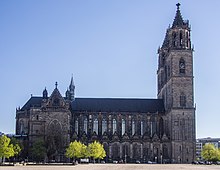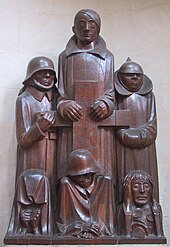
Magdeburg is the capital of the German state Saxony-Anhalt. The city is situated at the Elbe river.

Cologne Cathedral is a cathedral in Cologne, North Rhine-Westphalia belonging to the Catholic Church. It is the seat of the Archbishop of Cologne and of the administration of the Archdiocese of Cologne. It is a renowned monument of German Catholicism and Gothic architecture and was declared a World Heritage Site in 1996. It is Germany's most visited landmark, attracting an average of 6 million people a year. At 157 m (515 ft), the cathedral is the tallest twin-spired church in the world, the second tallest church in Europe after Ulm Minster, and the third tallest church of any kind in the world.

St. Stephen's Cathedral is the mother church of the Roman Catholic Archdiocese of Vienna and the seat of the Archbishop of Vienna, Christoph Cardinal Schönborn, OP. The current Romanesque and Gothic form of the cathedral, seen today in the Stephansplatz, was largely initiated by Duke Rudolf IV (1339–1365) and stands on the ruins of two earlier churches, the first a parish church consecrated in 1147. The most important religious building in Vienna, St. Stephen's Cathedral has borne witness to many important events in Habsburg and Austrian history and has, with its multi-coloured tile roof, become one of the city's most recognizable symbols. It has 256 stairs from the top to the bottom

Aachen Cathedral is a Catholic church in Aachen, Germany and the cathedral of the Diocese of Aachen.

Tours Cathedral is a Roman Catholic church located in Tours, Indre-et-Loire, France, and dedicated to Saint Gatianus. It is the seat of the Archbishops of Tours, the metropolitan cathedral of the Tours ecclesiastical province. It was built between 1170 and 1547. At the time construction began, the church was located at the south end of the bridge over the river Loire, on the road from Paris to the south-west of France. It has been a classified monument historique since 1862. Since 1905 it has been owned by the French State, with the Catholic Church having the exclusive rights of use.
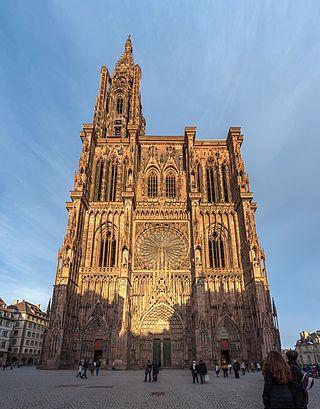
Strasbourg Cathedral or the Cathedral of Our Lady of Strasbourg, also known as Strasbourg Minster, is a Catholic cathedral in Strasbourg, Alsace, France. Although considerable parts of it are still in Romanesque architecture, it is widely considered to be among the finest examples of Rayonnant Gothic architecture. Architect Erwin von Steinbach is credited for major contributions from 1277 to his death in 1318, and beyond through his son Johannes von Steinbach, and his grandson Gerlach von Steinbach, who succeeded him as chief architects. The Steinbachs’ plans for the completion of the cathedral were not followed through by the chief architects who took over after them, and instead of the originally envisioned two spires, a single, octagonal tower with an elongated, octagonal crowning was built on the northern side of the west facade by master Ulrich Ensingen and his successor, Johannes Hültz. The construction of the cathedral, which had started in the year 1015 and had been relaunched in 1190, was finished in 1439.

Hildesheim Cathedral, officially the Cathedral of the Assumption of Mary or simply St. Mary's Cathedral, is a medieval Roman Catholic cathedral in the city centre of Hildesheim in Lower Saxony, Germany, that serves as the seat of the Diocese of Hildesheim. The cathedral has been on the UNESCO World Cultural Heritage list since 1985, together with the nearby St. Michael's Church because of its unique art and outstanding Romanesque architecture.
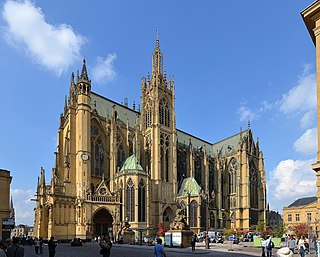
Metz Cathedral is the cathedral of the Catholic Diocese of Metz, the seat of the bishops of Metz. It is dedicated to Saint Stephen. The diocese dates back at least to the 4th century and the present cathedral building was begun in the early 14th century. In the mid-14th century, it was joined to the collegiate church of Notre-Dame, and given a new transept and late Gothic chevet, finished between 1486 and 1520. The cathedral treasury displays a rich collection assembled over the long centuries of the history of the Metz diocese and include sacred vestments and items used for the Eucharist.

St Peter's Cathedral is a Roman Catholic church and former cathedral in Worms, southern Germany.
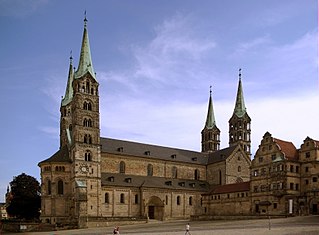
Bamberg Cathedral is a church in Bamberg, Germany, completed in the 13th century. The cathedral is under the administration of the Archdiocese of Bamberg and is the seat of the its archbishop. Since 1993, the cathedral has been part of the UNESCO World Heritage Site "Town of Bamberg".

Sens Cathedral is a Catholic cathedral in Sens in Burgundy, eastern France. The cathedral, dedicated to Saint Stephen, is the seat of the Archbishop of Sens.

Bremen Cathedral, dedicated to St. Peter, is a church situated in the market square in the center of Bremen. The cathedral belongs to the Bremian Evangelical Church, a member of the umbrella organization Protestant Church in Germany. It is the previous cathedral of the former Prince-Archbishopric of Bremen. Since 1973, it is protected by the monument protection act.

Bordeaux Cathedral, officially known as the Primatial Cathedral of St Andrew of Bordeaux, is a Catholic church dedicated to Saint Andrew and located in Bordeaux, France. It is the seat of the Archbishop of Bordeaux.
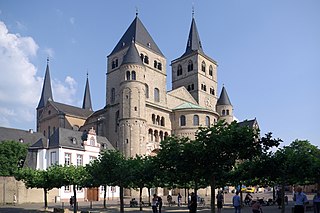
The High Cathedral of Saint Peter in Trier, or Trier Cathedral, is a Roman Catholic cathedral in Trier, Rhineland-Palatinate, Germany. It is the oldest church in Germany and the largest religious structure in Trier, notable for its long life span and grand design. The central part of the nave was built of Roman brick in the early fourth century, resulting in a cathedral that was added onto gradually in different eras. The imposing Romanesque westwork, with four towers and an additional apse, has been copied repeatedly. The Trier Cathedral Treasury contains an important collection of Christian art. In 1986 the church was listed as a UNESCO World Heritage Site, as part of the Roman Monuments, Cathedral of St. Peter and Church of Our Lady in Trier.
Imperial cathedral is the designation for a cathedral linked to the Imperial rule of the Holy Roman Empire.

Maurice was an Egyptian military leader who headed the legendary Theban Legion of Rome in the 3rd century, and is one of the favourite and most widely venerated saints of that martyred group. He is the patron saint of several professions, locales, and kingdoms.
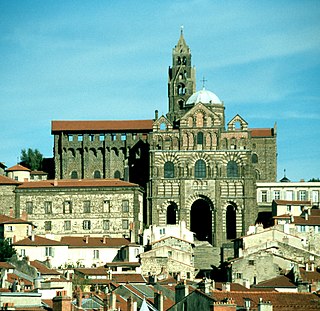
Le Puy Cathedral is a Roman Catholic church located in Le Puy-en-Velay, Auvergne, France. The cathedral is a national monument. It has been a centre of pilgrimage in its own right since before the time of Charlemagne, as well as being a stopover on the pilgrimage route to Santiago de Compostela. Since 1998 it has been part of a multi-location UNESCO World Heritage Site along France's Santiago pilgrimage routes. It is the seat of the Bishop of Le Puy.
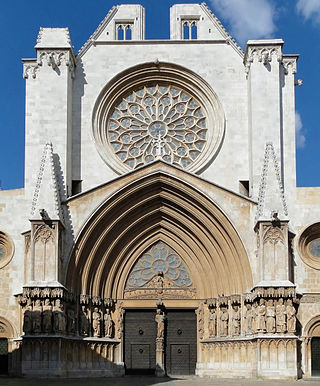
The Primatial Cathedral of Tarragona is a Roman Catholic church in Tarragona, Catalonia, Spain. The edifice is located in a site previously occupied by a Roman temple dating to the time of Tiberius, a Visigothic cathedral, and a Moorish mosque. It was declared a national monument in 1905.

Notre-Dame de Reims, known in English as Reims Cathedral, is a Roman Catholic cathedral in the French city of the same name, the archiepiscopal see of the Archdiocese of Reims. The cathedral was dedicated to the Virgin Mary and was the traditional location for the coronation of the kings of France. Reims Cathedral is considered to be one of the most important pieces of Gothic architecture. The cathedral, a major tourist destination, receives about one million visitors annually. It became a UNESCO World Heritage Site in 1991.

St Severus' Church in the city of Erfurt in Thuringia, Germany, is a Roman Catholic church building. It stands on the Domberg directly next to St Mary's Cathedral. As a unique architectural ensemble, both churches together form the city's landmark. Due to its unusual form, which seems to anticipate the late Gothic hall church, St Severus' Church is one of the most important Gothic buildings in Germany. The bones of the church patron Severus of Ravenna rest in an artistically very significant sarcophagus.
